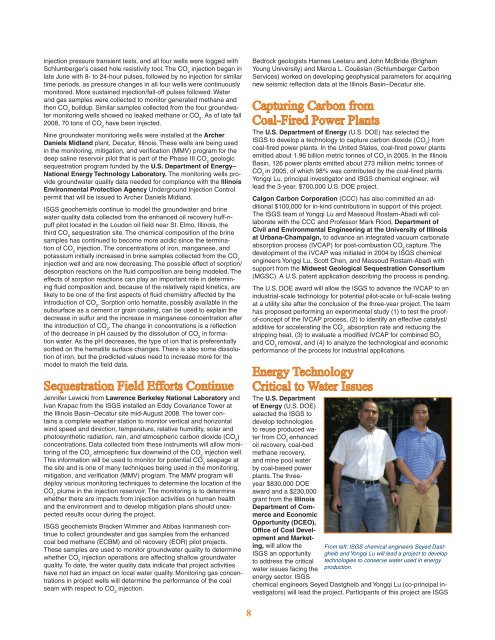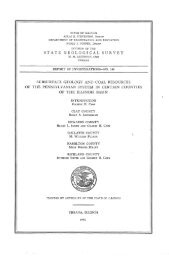2008 ISGS Annual Report - University of Illinois at Urbana-Champaign
2008 ISGS Annual Report - University of Illinois at Urbana-Champaign
2008 ISGS Annual Report - University of Illinois at Urbana-Champaign
You also want an ePaper? Increase the reach of your titles
YUMPU automatically turns print PDFs into web optimized ePapers that Google loves.
injection pressure transient tests, and all four wells were logged with<br />
Schlumberger’s cased hole resistivity tool. The CO 2 injection began in<br />
l<strong>at</strong>e June with 8- to 24-hour pulses, followed by no injection for similar<br />
time periods, as pressure changes in all four wells were continuously<br />
monitored. More sustained injection/fall-<strong>of</strong>f pulses followed. W<strong>at</strong>er<br />
and gas samples were collected to monitor gener<strong>at</strong>ed methane and<br />
then CO 2 buildup. Similar samples collected from the four groundw<strong>at</strong>er<br />
monitoring wells showed no leaked methane or CO 2 . As <strong>of</strong> l<strong>at</strong>e fall<br />
<strong>2008</strong>, 70 tons <strong>of</strong> CO 2 have been injected.<br />
Nine groundw<strong>at</strong>er monitoring wells were installed <strong>at</strong> the Archer<br />
Daniels Midland plant, Dec<strong>at</strong>ur, <strong>Illinois</strong>. These wells are being used<br />
in the monitoring, mitig<strong>at</strong>ion, and verific<strong>at</strong>ion (MMV) program for the<br />
deep saline reservoir pilot th<strong>at</strong> is part <strong>of</strong> the Phase III CO 2 geologic<br />
sequestr<strong>at</strong>ion program funded by the U.S. Department <strong>of</strong> Energy–<br />
N<strong>at</strong>ional Energy Technology Labor<strong>at</strong>ory. The monitoring wells provide<br />
groundw<strong>at</strong>er quality d<strong>at</strong>a needed for compliance with the <strong>Illinois</strong><br />
Environmental Protection Agency Underground Injection Control<br />
permit th<strong>at</strong> will be issued to Archer Daniels Midland.<br />
<strong>ISGS</strong> geochemists continue to model the groundw<strong>at</strong>er and brine<br />
w<strong>at</strong>er quality d<strong>at</strong>a collected from the enhanced oil recovery huff-npuff<br />
pilot loc<strong>at</strong>ed in the Loudon oil field near St. Elmo, <strong>Illinois</strong>, the<br />
third CO 2 sequestr<strong>at</strong>ion site. The chemical composition <strong>of</strong> the brine<br />
samples has continued to become more acidic since the termin<strong>at</strong>ion<br />
<strong>of</strong> CO 2 injection. The concentr<strong>at</strong>ions <strong>of</strong> iron, manganese, and<br />
potassium initially increased in brine samples collected from the CO 2<br />
injection well and are now decreasing. The possible effect <strong>of</strong> sorption/<br />
desorption reactions on the fluid composition are being modeled. The<br />
effects <strong>of</strong> sorption reactions can play an important role in determining<br />
fluid composition and, because <strong>of</strong> the rel<strong>at</strong>ively rapid kinetics, are<br />
likely to be one <strong>of</strong> the first aspects <strong>of</strong> fluid chemistry affected by the<br />
introduction <strong>of</strong> CO 2 . Sorption onto hem<strong>at</strong>ite, possibly available in the<br />
subsurface as a cement or grain co<strong>at</strong>ing, can be used to explain the<br />
decrease in sulfur and the increase in manganese concentr<strong>at</strong>ion after<br />
the introduction <strong>of</strong> CO 2 . The change in concentr<strong>at</strong>ions is a reflection<br />
<strong>of</strong> the decrease in pH caused by the dissolution <strong>of</strong> CO 2 in form<strong>at</strong>ion<br />
w<strong>at</strong>er. As the pH decreases, the type <strong>of</strong> ion th<strong>at</strong> is preferentially<br />
sorbed on the hem<strong>at</strong>ite surface changes. There is also some dissolution<br />
<strong>of</strong> iron, but the predicted values need to increase more for the<br />
model to m<strong>at</strong>ch the field d<strong>at</strong>a.<br />
Sequestr<strong>at</strong>ion Field Efforts Continue<br />
Jennifer Lewicki from Lawrence Berkeley N<strong>at</strong>ional Labor<strong>at</strong>ory and<br />
Ivan Krapac from the <strong>ISGS</strong> installed an Eddy Covariance Tower <strong>at</strong><br />
the <strong>Illinois</strong> Basin–Dec<strong>at</strong>ur site mid-August <strong>2008</strong>. The tower contains<br />
a complete we<strong>at</strong>her st<strong>at</strong>ion to monitor vertical and horizontal<br />
wind speed and direction, temper<strong>at</strong>ure, rel<strong>at</strong>ive humidity, solar and<br />
photosynthetic radi<strong>at</strong>ion, rain, and <strong>at</strong>mospheric carbon dioxide (CO 2 )<br />
concentr<strong>at</strong>ions. D<strong>at</strong>a collected from these instruments will allow monitoring<br />
<strong>of</strong> the CO 2 <strong>at</strong>mospheric flux downwind <strong>of</strong> the CO 2 injection well.<br />
This inform<strong>at</strong>ion will be used to monitor for potential CO 2 seepage <strong>at</strong><br />
the site and is one <strong>of</strong> many techniques being used in the monitoring,<br />
mitig<strong>at</strong>ion, and verific<strong>at</strong>ion (MMV) program. The MMV program will<br />
deploy various monitoring techniques to determine the loc<strong>at</strong>ion <strong>of</strong> the<br />
CO 2 plume in the injection reservoir. The monitoring is to determine<br />
whether there are impacts from injection activities on human health<br />
and the environment and to develop mitig<strong>at</strong>ion plans should unexpected<br />
results occur during the project.<br />
<strong>ISGS</strong> geochemists Bracken Wimmer and Abbas Iranmanesh continue<br />
to collect groundw<strong>at</strong>er and gas samples from the enhanced<br />
coal bed methane (ECBM) and oil recovery (EOR) pilot projects.<br />
These samples are used to monitor groundw<strong>at</strong>er quality to determine<br />
whether CO 2 injection oper<strong>at</strong>ions are affecting shallow groundw<strong>at</strong>er<br />
quality. To d<strong>at</strong>e, the w<strong>at</strong>er quality d<strong>at</strong>a indic<strong>at</strong>e th<strong>at</strong> project activities<br />
have not had an impact on local w<strong>at</strong>er quality. Monitoring gas concentr<strong>at</strong>ions<br />
in project wells will determine the performance <strong>of</strong> the coal<br />
seam with respect to CO 2 injection.<br />
8<br />
Bedrock geologists Hannes Leetaru and John McBride (Brigham<br />
Young <strong>University</strong>) and Marcia L. Couëslan (Schlumberger Carbon<br />
Services) worked on developing geophysical parameters for acquiring<br />
new seismic reflection d<strong>at</strong>a <strong>at</strong> the <strong>Illinois</strong> Basin–Dec<strong>at</strong>ur site.<br />
Capturing Carbon from<br />
Coal-Fired Power Plants<br />
The U.S. Department <strong>of</strong> Energy (U.S. DOE) has selected the<br />
<strong>ISGS</strong> to develop a technology to capture carbon dioxide (CO 2 ) from<br />
coal-fired power plants. In the United St<strong>at</strong>es, coal-fired power plants<br />
emitted about 1.96 billion metric tonnes <strong>of</strong> CO 2 in 2005. In the <strong>Illinois</strong><br />
Basin, 126 power plants emitted about 273 million metric tonnes <strong>of</strong><br />
CO 2 in 2005, <strong>of</strong> which 98% was contributed by the coal-fired plants.<br />
Yongqi Lu, principal investig<strong>at</strong>or and <strong>ISGS</strong> chemical engineer, will<br />
lead the 3-year, $700,000 U.S. DOE project.<br />
Calgon Carbon Corpor<strong>at</strong>ion (CCC) has also committed an additional<br />
$100,000 for in-kind contributions in support <strong>of</strong> this project.<br />
The <strong>ISGS</strong> team <strong>of</strong> Yongqi Lu and Massoud Rostam-Abadi will collabor<strong>at</strong>e<br />
with the CCC and Pr<strong>of</strong>essor Mark Rood, Department <strong>of</strong><br />
Civil and Environmental Engineering <strong>at</strong> the <strong>University</strong> <strong>of</strong> <strong>Illinois</strong><br />
<strong>at</strong> <strong>Urbana</strong>-<strong>Champaign</strong>, to advance an integr<strong>at</strong>ed vacuum carbon<strong>at</strong>e<br />
absorption process (IVCAP) for post-combustion CO 2 capture. The<br />
development <strong>of</strong> the IVCAP was initi<strong>at</strong>ed in 2004 by <strong>ISGS</strong> chemical<br />
engineers Yongqi Lu, Scott Chen, and Massoud Rostam-Abadi with<br />
support from the Midwest Geological Sequestr<strong>at</strong>ion Consortium<br />
(MGSC). A U.S. p<strong>at</strong>ent applic<strong>at</strong>ion describing the process is pending.<br />
The U.S. DOE award will allow the <strong>ISGS</strong> to advance the IVCAP to an<br />
industrial-scale technology for potential pilot-scale or full-scale testing<br />
<strong>at</strong> a utility site after the conclusion <strong>of</strong> the three-year project. The team<br />
has proposed performing an experimental study (1) to test the pro<strong>of</strong><strong>of</strong>-concept<br />
<strong>of</strong> the IVCAP process, (2) to identify an effective c<strong>at</strong>alyst/<br />
additive for acceler<strong>at</strong>ing the CO 2 absorption r<strong>at</strong>e and reducing the<br />
stripping he<strong>at</strong>, (3) to evalu<strong>at</strong>e a modified IVCAP for combined SO 2<br />
and CO 2 removal, and (4) to analyze the technological and economic<br />
performance <strong>of</strong> the process for industrial applic<strong>at</strong>ions.<br />
Energy Technology<br />
Critical to W<strong>at</strong>er Issues<br />
The U.S. Department<br />
<strong>of</strong> Energy (U.S. DOE)<br />
selected the <strong>ISGS</strong> to<br />
develop technologies<br />
to reuse produced w<strong>at</strong>er<br />
from CO 2 enhanced<br />
oil recovery, coal-bed<br />
methane recovery,<br />
and mine pool w<strong>at</strong>er<br />
by coal-based power<br />
plants. The threeyear<br />
$830,000 DOE<br />
award and a $230,000<br />
grant from the <strong>Illinois</strong><br />
Department <strong>of</strong> Commerce<br />
and Economic<br />
Opportunity (DCEO),<br />
Office <strong>of</strong> Coal Development<br />
and Market-<br />
ing, will allow the<br />
<strong>ISGS</strong> an opportunity<br />
to address the critical<br />
w<strong>at</strong>er issues facing the<br />
energy sector. <strong>ISGS</strong><br />
From left: <strong>ISGS</strong> chemical engineers Seyed Dastgheib<br />
and Yongqi Lu will lead a project to develop<br />
technologies to conserve w<strong>at</strong>er used in energy<br />
production.<br />
chemical engineers Seyed Dastgheib and Yongqi Lu (co-principal investig<strong>at</strong>ors)<br />
will lead the project. Participants <strong>of</strong> this project are <strong>ISGS</strong>

















